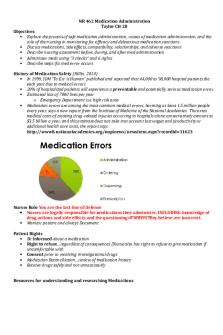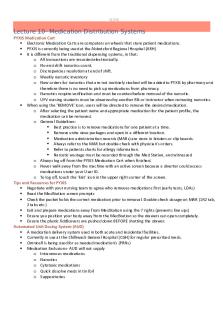Administration of non parenteral Medication post test 3 PDF

| Title | Administration of non parenteral Medication post test 3 |
|---|---|
| Author | Lisbeth Valencia |
| Course | Nursing Fundamental Concepts |
| Institution | Herzing University |
| Pages | 3 |
| File Size | 95.8 KB |
| File Type | |
| Total Downloads | 1 |
| Total Views | 140 |
Summary
Material to help you study for the post-test....
Description
1. 1.ID: 18668363787 Which patient is at lowest risk for a systemic effect from a topical agent? A patient who: A.
is very mobile and receiving a drug in low concentration. Correct *a. Systemic effects from medications applied directly to the skin can occur if the skin is thin, if drug concentration is high, or if contact with the skin is prolonged. A patient who is receiving a drug topically in low concentration is the patient at least risk for developing a systemic effect. b. Incorrect. Patients who have received radiation therapy often have a thinning of their tissues. Systemic effects from medications applied directly to the skin can occur if the skin is thin, if drug concentration is high, or if contact with the skin is prolonged. c. Incorrect. Prolonged contact with the skin increases the risk for systemic effect of a topical agent. d. Incorrect. If drug concentrations are high, as can occur when taking a medication both topically and orally, an increased likelihood of systemic effects can result.
B.
had radiation and is receiving topical ointment for the skin burn.
C.
has ointment reapplied frequently for a skin graft.
D. is taking a medication to reduce itching both topically and orally. Awarded 1.0 points out of 1.0 possible points. 2. 2.ID: 18668363785 A patient has been hospitalized for several days after a motor vehicle accident. The patient has several fractured bones and has cuts and scratches across the chest area. Where should you apply the fentanyl (Duragesic) patch to treat the patient's pain? A.
Over one of the cuts and/or scratches so it is absorbed more quickly.
B.
Over a previous scar to cause less pain.
C.
On the patient’s nondominant forearm.
D.
On the upper back in an area that is free of hair. Correct a. You should never apply the patch to skin that is oily, burned, cut, or irritated in any way because this will affect absorption. b. Application on hairy surfaces or scar tissue may interfere with absorption. c. The forearm is an inappropriate site for a transdermal patch. The upper arm has adequate circulation and subcutaneous tissue for absorption. *d. Appropriate sites include the chest area, back, upper arm, or legs where there is adequate circulation and subcutaneous tissue for absorption.
Awarded 1.0 points out of 1.0 possible points.
3. 3.ID: 18668363781 You don clean gloves and measure the antianginal ointment onto dosage paper according to health care provider's orders. You rub the ointment off the paper directly onto the female patient's skin of the anterior chest and cover the area of ointment with plastic wrap and tape. You discard the gloves and perform hand hygiene. Which steps of the procedure were incorrect and/or missing? (Select all that apply.) A.
You did not remove the previous dosage paper. Correct
B.
You rubbed the ointment off the paper and covered with pastic wrap. Correct
C.
You did not write the date, time, and initials on the paper wrapper. Correct
D.
You wore nonsterile gloves.
E. You applied the ointment to the anterior chest wall. Failing to remove the previous dosage paper could lead to overdose. You should leave the dosage paper in place on the patient's skin and avoid rubbing the ointment. Rubbing the ointment may increase absorption. Covering the ointment with plastic wrap increases rate of absorption. The ointment and dosage paper are left in place, and the date, time, and your initials are written on the dosage paper to promote accuracy. The paper is covered with plastic wrap and secured with tape to prevent staining of the clothes and/or accidental removal of the medication. You should wear clean gloves to prevent absorption of antianginal ointment on your skin. It is appropriate to apply the ointment to the anterior chest wall as long as it is a nonhairy surface (as it would be with a female patient). Awarded 3.0 points out of 3.0 possible points. 4. 4.ID: 18668363783 What should the nurse do to maximize the effectiveness of medicated lotions and/or ointment? A. B.
Apply a thick, even layer. First wash area with nondrying soap and water. Correct a. The skin should be cleansed gently and thoroughly with soap and water before medications are applied. When medication is applied over skin encrustation, the dead tissues harbor microorganisms and block contact of the medication with the tissues to be treated. *b. The skin should be cleansed gently and thoroughly with soap and water before medications are applied. When medication is applied over skin encrustation, the dead tissues harbor microorganisms and block contact of the medication with the tissues to be treated. c. The dose paper may be applied over the upper arm, not the lower arm. d. The ointment should not be massaged as this can affect the rate of absorption.
C.
Apply the dose paper over a nonhairy area of the lower arm.
D.
Massage the ointment into the skin.
Awarded 1.0 points out of 1.0 possible points. 5. 5.ID: 18668363779 The hospice nurse comes to the home of a patient with terminal cancer. She discovers several fentanyl (Duragesic) pain patches on the patient’s body. What should the nurse do first? A.
Notify the health care provider that the patient is not getting sufficient pain relief.
B.
Remove the patches except for the most recent and provide patient teaching. Correct a. The nurse cannot assume the patient is getting insufficient pain relief. It may be a lack of knowledge to remove the old transdermal patch before applying a new one. Further assessment needs to be made, but for patient safety, the nurse should first remove the excess pain patches. *b. Correct! The nurse needs to determine if there is a transdermal patch applied for the current period and remove all others. The nurse needs to instruct the patient to remove the old pain patch, fold with insides together, and discard appropriately before applying a new transdermal patch because prolonged or high doses can cause toxic systemic effects such as respiratory depression. The patient should be instructed to keep transdermal fentanyl patches out of the reach of children. The nurse may assess the patient further, including a pain assessment, and notify the health care provider. c. It is unnecessary to remove excess transdermal pain patches in a tapered fashion. d. The nurse should first remove the excess transdermal pain patches and provide teaching.
C.
Have the patient remove one pain patch every hour until they are all removed.
D. Assess the patient’s level of pain and skin for any irritation. Awarded 1.0 points out of 1.0 possible points....
Similar Free PDFs

Test 1 Medication Administration
- 9 Pages

Medication Administration
- 3 Pages

Medication Administration
- 6 Pages

Chapter 31 Medication Administration
- 18 Pages

Chapter 31 Medication Administration
- 27 Pages

Chapter 35 Medication Administration
- 16 Pages
Popular Institutions
- Tinajero National High School - Annex
- Politeknik Caltex Riau
- Yokohama City University
- SGT University
- University of Al-Qadisiyah
- Divine Word College of Vigan
- Techniek College Rotterdam
- Universidade de Santiago
- Universiti Teknologi MARA Cawangan Johor Kampus Pasir Gudang
- Poltekkes Kemenkes Yogyakarta
- Baguio City National High School
- Colegio san marcos
- preparatoria uno
- Centro de Bachillerato Tecnológico Industrial y de Servicios No. 107
- Dalian Maritime University
- Quang Trung Secondary School
- Colegio Tecnológico en Informática
- Corporación Regional de Educación Superior
- Grupo CEDVA
- Dar Al Uloom University
- Centro de Estudios Preuniversitarios de la Universidad Nacional de Ingeniería
- 上智大学
- Aakash International School, Nuna Majara
- San Felipe Neri Catholic School
- Kang Chiao International School - New Taipei City
- Misamis Occidental National High School
- Institución Educativa Escuela Normal Juan Ladrilleros
- Kolehiyo ng Pantukan
- Batanes State College
- Instituto Continental
- Sekolah Menengah Kejuruan Kesehatan Kaltara (Tarakan)
- Colegio de La Inmaculada Concepcion - Cebu









